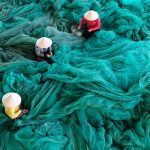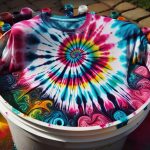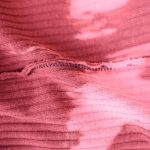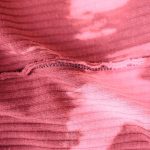Are you confused about the difference between garment dyeing and pigment dyeing? Choosing the right dyeing method can have a big impact on the final look and feel of your clothing. Garment dyeing and pigment dyeing are two popular methods used in the fashion industry to add color to fabrics.
In this article, we’ll explore the differences between these two techniques and help you decide which one is best for your garment.
Garment dyeing involves dyeing the fabric after it has been cut and sewn into a garment. This process allows for a more even and consistent color throughout the entire garment, including seams and edges.
On the other hand, pigment dyeing involves applying color to the surface of the fabric using a pigment that adheres to the fibers. This results in a more textured and distressed look, with the color often appearing more washed out or faded.
Understanding the pros and cons of each method will help you make an informed decision when it comes to dyeing your garments.
Table of Contents
What is Garment Dyeing?
So, you’re wondering what garment dyeing is? Well, it’s a process where pre-made garments are dyed after they’ve been sewn together, resulting in a unique, vintage look.
Garment dyeing is a popular technique used by clothing manufacturers to create a wide range of colors and shades that can’t be achieved through traditional dyeing methods. This process is particularly popular in the fashion industry because it allows designers to experiment with different colors and finishes.
The garment dyeing process involves first washing the garments to remove any dirt or impurities. Then, they’re soaked in a dye solution and agitated to ensure that the dye is evenly distributed. The garments are then rinsed to remove any excess dye and dried.
One of the advantages of garment dyeing is that it produces a soft, worn-in feel that’s comfortable to wear. In addition, the dyeing process can also help to reduce shrinkage and improve colorfastness.
Garment dyeing can be used to create a variety of different effects, including subtle color variations, distressed finishes, and vintage washes. This technique is particularly popular for denim jeans, which are often dyed using a variety of different colors to create a unique, personalized look.
So, if you’re looking for a garment that has a one-of-a-kind look and feel, then garment dyeing may be the perfect choice for you.
What is Pigment Dyeing?
Get ready to fall in love with the unique and edgy look achieved through pigment dyeing. This type of coloring process involves adding pigments to a fabric’s surface, rather than dyeing it completely. The result is a slightly faded, vintage-inspired look that is perfect for achieving a lived-in, casual feel.
Unlike garment dyeing, pigment dyeing doesn’t require the fabric to be pre-washed or pre-shrunk. This means that the process is more forgiving and can be done on a wider range of fabrics. The pigments used are also more versatile, allowing for a wider range of colors to be achieved.
One thing to keep in mind when pigment dyeing is that the color may fade over time, as the pigments are only applied to the surface of the fabric. However, this can also add to the unique character and charm of the garment.
Overall, pigment dyeing is a great option for achieving a relaxed, lived-in look that’s both stylish and comfortable.
Differences between Garment Dyeing and Pigment Dyeing
You may distinguish between the two dyeing techniques by examining the depth of color saturation achieved, as well as the levels of pre-washing and fabric versatility required. Garment dyeing, for instance, penetrates the fabric more deeply, resulting in a more intense color and a softer hand feel. Pigment dyeing, on the other hand, sits on the surface of the fabric, producing a more muted color and a stiffer texture.
Here are some key differences between garment dyeing and pigment dyeing:
-
Garment dyeing requires pre-washing before dyeing, while pigment dyeing does not. This is because the fabric needs to be free of any finishing agents or impurities that may interfere with the dye penetration in garment dyeing.
-
Garment dyeing can be done on a wider range of fabrics, including natural and synthetic fibers, while pigment dyeing is typically restricted to natural fibers like cotton, linen, and silk.
-
Garment dyeing is more durable and resistant to fading than pigment dyeing, which tends to fade over time with repeated washing and exposure to sunlight.
-
Garment dyeing allows for more customization and control over the final color, as the dye can be adjusted during the dyeing process to achieve the desired shade. Pigment dyeing, on the other hand, is more unpredictable, as the final color can be affected by various factors such as the fabric type, dye concentration, and dyeing temperature.
Overall, the choice between garment dyeing and pigment dyeing depends on the desired outcome and the fabric type. Garment dyeing is ideal for achieving a vibrant, long-lasting color on a wider range of fabrics, while pigment dyeing is better suited for achieving a more muted, vintage look on natural fibers.
When to Use Garment Dyeing
Determining the appropriate dyeing technique depends on the desired outcome and fabric material, with garment dyeing being a suitable option for achieving intense, long-lasting color on a variety of materials. This process involves dyeing the finished garment after it has been sewn, resulting in a softer look and feel compared to pigment dyeing. Garment dyeing works well on materials such as cotton, linen, and rayon.
To further understand when garment dyeing is the right choice, consider the following table:
| Material | Suitability for Garment Dyeing |
|---|---|
| Cotton | Highly suitable |
| Rayon | Highly suitable |
| Linen | Highly suitable |
| Silk | Somewhat suitable |
| Wool | Not suitable |
As seen in the table, garment dyeing is highly suitable for cotton, rayon, and linen. It is important to note that wool is not suitable for garment dyeing, as it is a protein fiber that requires special treatment. Additionally, silk can be dyed using this method, but it may result in a more muted color due to the fiber’s natural luster.
Ultimately, when considering garment dyeing, it is important to evaluate the fabric material and desired outcome. This process can result in vibrant, long-lasting color that is perfect for creating a unique and personalized garment.
When to Use Pigment Dyeing
When considering color options for fabrics, it’s important to understand that pigment dyeing offers a different look and feel compared to other dyeing techniques. Pigment dyeing involves applying color to the surface of the fabric, rather than penetrating the fibers like garment dyeing.
This results in a more washed-out, vintage appearance that can be desirable for certain styles and applications. If you’re looking to achieve a specific color or shade, pigment dyeing may not be the best option. Because the color sits on top of the fabric, it can be difficult to achieve the same level of color consistency and vibrancy as with garment dyeing.
In addition, pigment dyeing may fade more quickly over time, especially with repeated washing or exposure to sunlight. However, if you’re going for a more relaxed, lived-in look, pigment dyeing can be a great choice.
It’s often used in casual clothing like t-shirts and sweatshirts, as well as in home decor items like curtains and bedding. With pigment dyeing, you can create a unique, one-of-a-kind piece that has a soft, comfortable feel and a subtle, vintage-inspired color palette.
Cost Considerations
When it comes to cost considerations in garment and pigment dyeing, there are several factors to keep in mind. The type of fabric being dyed, the dyeing process used, and the quantity of garments being produced can all affect the final cost.
Comparing the cost of garment dyeing versus pigment dyeing can also help determine which method is more cost-effective for your specific needs.
Factors That Affect Cost
One factor that affects the cost of garment dyeing versus pigment dyeing is the amount of fabric you are dyeing. If you have a smaller batch of fabric, pigment dyeing may be more cost-effective since it requires less dye to color the fabric.
On the other hand, if you have a larger batch of fabric, garment dyeing may be the better choice since it is better suited for larger quantities. Another factor that can impact the cost is the complexity of the dyeing process.
Garment dyeing involves dyeing the fabric after it has been cut and sewn into its final form, whereas pigment dyeing is typically done on pre-made fabric. This means that garment dyeing can be more time-consuming and labor-intensive, which can drive up the cost.
Additionally, the type of dye used can also affect the cost, as some dyes may be more expensive than others. Ultimately, it’s important to consider all of these factors when deciding which dyeing method to use for your project.
Cost Comparison between Garment and Pigment Dyeing
Now that you know the factors that affect the cost of garment and pigment dyeing, let’s compare the costs between the two techniques. It’s important to note that the cost will vary depending on the specific project and the quantity of items being dyed, but we can still look at some general comparisons.
To help you visualize the cost comparison, we’ve created a table below. This table compares the average cost per garment for both garment dyeing and pigment dyeing for a small, medium, and large order. As you can see, garment dyeing can be more expensive than pigment dyeing, especially for smaller orders. However, as the order size increases, the cost per garment decreases for both techniques, with pigment dyeing generally being less expensive overall. Keep in mind that these are just averages and that the specific cost for your project may differ.
| Order Size | Garment Dyeing Cost per Garment | Pigment Dyeing Cost per Garment |
|---|---|---|
| Small (Less than 50 garments) | $10 – $20 | $5 – $10 |
| Medium (50 – 1000 garments) | $5 – $10 | $3 – $8 |
| Large (Over 1000 garments) | $3 – $7 | $2 – $6 |
Overall, when it comes to cost, pigment dyeing is generally less expensive than garment dyeing, especially for smaller orders. However, it’s important to consider the specific needs and goals of your project when deciding which technique to use. If you’re looking for vibrant, long-lasting colors and are willing to pay a bit more, garment dyeing may be the better option. On the other hand, if cost is the primary concern and you’re okay with more muted colors, pigment dyeing may be the way to go.
- How Does Ring Spun Cotton Affect Garment Fit and Shape Retention? - August 13, 2024
- What Are the Challenges in Producing Ring Spun Cotton? - August 13, 2024
- Is Ring Spun Cotton Suitable for Plus-Size Clothing? - August 13, 2024






